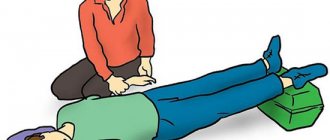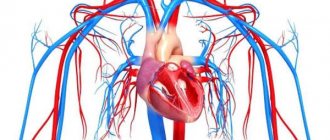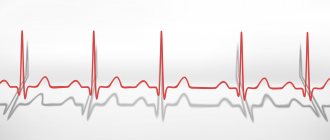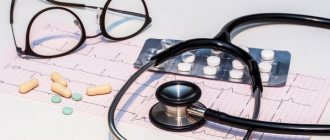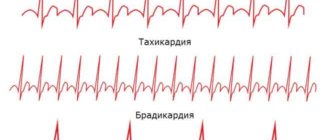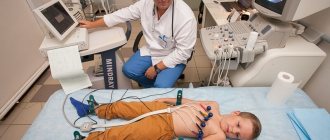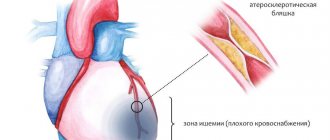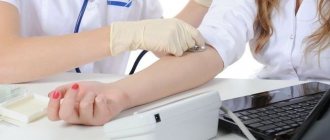Pulse is the rhythmic movement of blood through the veins as a result of myocardial contractions and pressure during one cardiac cycle. In medicine, the norm for a healthy person is considered to be 60-90 beats/minute. Only medical workers measure the pulse and give a verdict on abnormalities. They find out the causes of this pathology and give recommendations on how to increase your heart rate.
It is generally accepted that each age will have its own normal indicators:
- in newborns - 100-150 beats per minute;
- children (after 10 years) and adults 60-100;
- for athletes – 40-60.
A reduced heart rate is established after several measurements and is designated by the term bradycardia.
You can measure your heart rate using modern devices or using points on your body. They are located on the wrist, at the temple, on the bend of the elbow and knees, in the groin and on the neck in the area of the carotid arteries.
Causes of low heart rate
Bradycardia for no apparent reason is the most dangerous condition. In this case, the therapist or pediatrician prescribes tests, in-depth diagnostics (ultrasound of the heart, ECG) and consultations with a cardiologist.
Reasons for low heart rate may include:
- changes in the heart associated with aging;
- stressful frequent or prolonged conditions;
- disruption of the endocrine system (hypothyroidism);
- arterial hypertension;
- electrolyte imbalance in the body;
- accumulation of iron in the body (hemochromatosis);
- intoxication;
- vascular atherosclerosis;
- cardiac ischemia;
- contracting infections;
- increased intracranial pressure;
- vegetative-vascular dystonia;
- myocarditis;
- heart defects;
- cardiosclerosis after a heart attack;
- taking medications and dietary supplements.
Cases when a person has a low pulse, but at the same time he feels good and does not complain about his health, are called physiological. Treatment is not required, especially if examinations have been carried out for heart pathologies and none were found.
Physiological bradycardia is especially often observed in athletes, being a sign of high endurance of their cardiovascular system.
How to choose a therapy method?
If you notice a decrease in heart rate, do not rush into treatment - you will always have time to do this. The main thing is to determine what reasons provoked the deviation. This can be done by a cardiologist after undergoing a full examination. What factors are of primary importance?
- Heart rate - accordingly, the lower the indicators, the more emergency therapy is required. If the pulse drops to 35 beats per minute, a team of doctors is called immediately. If the indicators remain at around 50-55 beats, folk remedies or medications will be enough;
- Blood pressure - the fact is that drugs that increase your pulse usually increase your blood pressure; if you suffer from hypertension, treatment may result in a myocardial infarction;
- Physical fitness and endurance of the body - when a person is professionally and intensively involved in sports, even reduced heart rates are the norm and do not require additional therapy;
- The presence of other cardiac diseases, since taking medications can lead to complications. Accordingly, the doctor will determine whether there are contraindications;
- Diabetes mellitus, blood clots in blood vessels - the use of even folk remedies will be questionable, because with an increase in heart rate, the load on the arteries will also increase;
- The presence of allergic reactions - an examination is carried out in order to understand whether folk remedies can be used or not.
Thus, after undergoing a comprehensive diagnosis, you will be able to determine which measures are not contraindicated for you, and which will have to be abandoned. The age of the patient is also taken into account - it is more difficult for older people to undergo surgery.
Treatment for low heart rate with a doctor
Bradycardia that does not cause other symptoms does not require treatment.
The local doctor or cardiologist must tell you how to raise your pulse. Even if the patient himself decides to use the methods below, he should consult with the specified specialists. If the condition worsens, you should stop using the recommendations and call an ambulance. Before prescribing this or that drug, the specialist finds out the cause of the pathological condition.
It is customary to treat regular bradycardia with medications if it is accompanied by the following symptoms: low blood pressure, rapid loss of performance, signs of heart disease, a drop in heart rate (HR) to 40 beats. Unfortunately, there are no medications that can effectively raise your heart rate at home.
Low heart rate is treated in the following ways:
- drug treatment of diseases that caused bradycardia;
- pacemaker implantation;
- canceling or adjusting the dosage of medications taken that could cause a drop in heart rate.
If you need to raise your heart rate quickly enough, use injections of atropine, adrenaline or isoprenaline.
Drugs to increase heart rate can cause harm, so do not rush to take them without medical advice.
For mild bradycardia, the therapist prescribes Eleuctorococcus, ginseng or belladonna extracts. The doctor determines the dose and frequency of administration based on the patient’s condition and other illnesses.
Physiotherapy and exercise therapy
A slight decrease in heart rate does not always require active treatment with medications. To begin with, it is recommended to try simple reflex methods, including taking a hot bath, which helps to increase the heart rate. Minor physical activity, for example, swimming, walking, running, gives a good effect.
In addition, you can resort to performing 4 simple exercises:
- In a standing position, you need to raise your arms up for a few seconds, and then sharply lower them down.
- Lying on your back, perform the “bicycle” exercise with your legs. Perform manipulations 20 times in both directions.
- In a lying position, bend your knees and clasp them with your hands. Making every effort, you should try to open your arms with the help of your knees.
- Perform smooth head turns left and right.
In addition to the exercises, you can use mustard baths or local compresses on the back of the head. Such activities contribute to a significant improvement in blood flow to the muscles, and as a result, a sharp increase in heart rate.
Treatment depending on the cause of development
If a person does not have any symptoms other than an increased pulse, then treatment for this condition is not required. Depending on the type of disease that the doctor identifies, one or another therapy is prescribed. If bradycardia was caused by hypothyroidism or apnea, then by curing these diseases, the pulse rate will return to normal.
Hypothyroidism is a disease of the thyroid gland, often accompanied by bradycardia and low blood pressure. The basis for the treatment of bradycardia in hypothyroidism is hormone replacement therapy with L-thyroxine. To improve the condition and suppress symptoms, the following drugs are prescribed: Mildronate, Trimetazidine, ATP and other cardioprotectors, vitamins (Milgama, Undevit), L-carnitine.
Another disease accompanied by bradycardia is chronic renal failure (CRF). Renal replacement therapy is prescribed for irreversible consequences and maintains normal organ function.
Hemodialysis for chronic renal failure can be performed on an outpatient basis using an artificial kidney device. At home, peritoneal dialysis is used instead of hemodialysis. Renal replacement therapy cleanses the blood, normalizes pulse and blood pressure, removes toxins and stabilizes electrolyte balance.
If atrioventricular conduction in the heart is impaired, Izadrin is prescribed to increase heart rate. The dosage is selected individually based on the patient's medical history. The drug has side effects - tremor, dry mucous membranes, hormonal imbalance, nausea. Often such conditions can occur when the dose is exceeded and individual intolerance. Orciprenaline sulfate has a similar effect.
In older people, pathology is often caused by taking medications, especially drugs to support cardiac function. Be sure to tell your doctor about all the pills you take. This way, the specialist will be able to adjust the treatment and offer analogues of drugs, but without the side effect of bradycardia.
If drug therapy is powerless, a pacemaker will be needed. This small device is implanted in the area under the collarbone. Wires from it pass through the veins to the heart. The pacemaker adjusts the heart rate without increasing blood pressure. Modern models of such devices can record information for a cardiologist.
How to raise a low heart rate at home?
A drop in heart rate can be life-threatening. Therefore, if bradycardia took you by surprise, then how to increase your heart rate at home quickly and without harming your health?
The answer is very simple - if there are no signs of danger to life, nothing needs to be done until the ambulance arrives. Otherwise, the pulse becomes so rare that the patient needs closed heart massage.
Prevention
To prevent bradycardia, you need to reduce the risk of heart disease. If a person already has heart problems, then it is necessary to follow the treatment plan of a cardiologist.
To maintain normal cardiac activity, a number of recommendations should be followed:
- regular moderate physical activity;
- eating healthy foods - fruits, vegetables, lean meat, fish, cereals;
- prevent obesity;
- control blood pressure and cholesterol levels;
- do not abuse alcohol and do not smoke; for some diseases, drinking alcoholic beverages is prohibited;
- be observed by a specialist if alarming symptoms occur (pain in the heart area, under the shoulder blade, shortness of breath, fatigue, etc.);
- Use fatty and cholesterol-rich foods with caution;
- strictly follow your doctor's instructions for treating existing heart problems.
If your symptoms change for the worse or for the better, you must inform your doctor.
The danger of low heart rate
A low heart rate can appear as a result of disruptions in cardiac function, gastrointestinal pathology, nervous conditions and endocrine pathologies. A low heart rate may be a sign of increased potassium levels in the blood and an overdose of medications, including beta blockers.
Bradycardia is dangerous because it causes insufficient blood circulation to the brain and the whole body, which leads to various dysfunctions of different organs:
- Frequent fainting conditions.
- Heart failure.
- Sudden cardiac arrest and death.
Bradycardia is a common occurrence in pregnant women, and to get rid of it you need to take an upright position and rest. You need to be alarmed if the symptom recurs frequently and is accompanied by dizziness, lack of air, headaches, and lethargy. In this case, the woman must tell her gynecologist about the symptoms.
Treating bradycardia with folk remedies without going to the doctor can worsen the disease. The opportunity to early diagnose kidney failure, heart problems, hypothyroidism and other serious diseases is lost.
Phytotherapy
A course of herbal treatment will help get rid of bradycardia:
- Stimulating tinctures of eleutherococcus, ginseng, Rhodiola rosea. Pharmaceutical preparations are taken 20 drops three times a day for 2 months.
- Yarrow decoction: 15 g of dry raw material is brewed with a glass of boiling water and left for 1 hour in a thermos. Take a tablespoon in the morning, afternoon and evening. Stop taking the decoction when the pulse finally returns to normal.
- Tincture of young pine shoots: for 300 g of vodka you will need 60 g of raw materials. After 10 days, you can take it one teaspoon twice a day.
- Rose hips help with bradycardia caused by conduction disorders. 10 berries are boiled in 400 ml of water for 15 minutes. Then the broth is filtered, 2 tbsp is added to it. spoons of honey. Take 50 ml 30 minutes before meals.
Any folk remedies, physical activity and other home methods for treating bradycardia should be agreed with a doctor and used only after a thorough medical examination.
